It was due to Fathers, Dominicans specifically, that chocolate came to be appreciated by the Spanish, when in 1544, they tantalized the court with prepared chocolate presented by a Kekchi Maya delegation of New World natives. Faith indeed spread chocolate along routes, leading to new regions of the world, into new religious contexts, and into new appreciation. As Europeans slowly acquired a taste for it, celebratory chocolate enhanced many Christian settings. Church leaders depended on chocolate for physical, economic, and spiritual sustenance. Eventually the chocolate appetites of sixteenth-and seventeenth-century Christian religious enrobed many members of the Church in the Old World. For them, chocolate became an instrument of adulation, an offering for the greater glory of God. In Spain, monks made chocolate, drank it in secret, and hoarded their supplies and recipes. The Cistercians at Poblet designated a special room for chocolate drinking. Early adopter Alphonse de Richelieu (b. 1585), cardinal of Paris, was among the first there to experience chocolate, when his protégé Cardinal Mazarin brought a personal chocolate maker with him from Italy. In 1634 Mexican Jesuits were shipping chocolate to their brothers in Rome by way of Seville. At a party in his palace, thrown by the viceroy of Valencia honoring the seventh birthday of King Charles II on November 6, 1669, the winning poetry verses claimed chocolate as "manna" preparing one for heaven. For his submission to the contest, a Carmelite friar referred to chocolate as "that inspirational Ambrosia." Jesuit Father Roberti treated himself to a drink of what he called the "Mexican nectar" at his morning meal. He also sought inspiration from a bowl of chocolate when writing.
Chocolate provided good road food as the church extended its mission to California along the El Camino Real of twenty-one missions. The excitement about cacao and chocolate journeyed there through Franciscans such as Father Junípero Serra. When Father Serra left Spain for his duties in the New World, he nestled chocolate in his personal belongings. When storms required his ship to make port at Puerto Rico and the captain reneged on his promise to feed them, a local Christian mission provided sustenance in the form of chocolate. Serra reported: "For eighteen days we ate better than in any convent, all drinking chocolate every day."
Many fine chocolatiers make delicacies called mendiants. These immortalize the mendicant (beggar) orders-Augustinians, Carmelites, Dominicans, and Franciscans-those that serve the poor and rely only on donations for support. Each nut and dried fruit in the mendiant symbolizes the color of the respective monastic robes: raisins for Dominicans, hazelnuts for Augustinians, dried figs for Franciscans, and almonds for Carmelites. A perfect gift for Dad.
Adapted from On the Chocolate Trail: A Delicious Adventure Connecting Jews, Religions, History, Travel, Rituals and Recipes to the Magic of Cacao, published by Jewish Lights.

